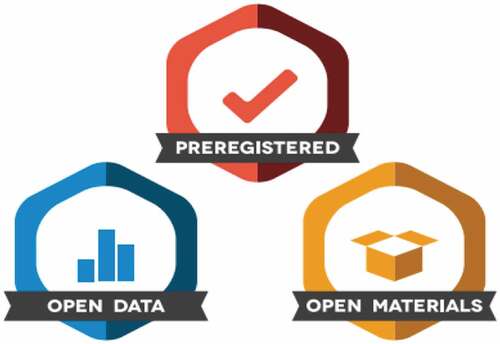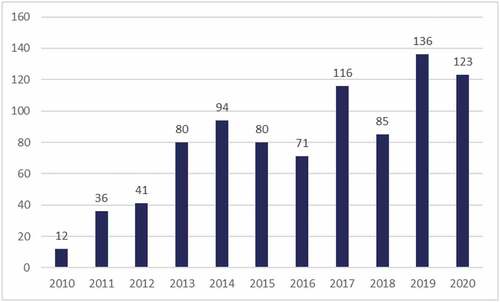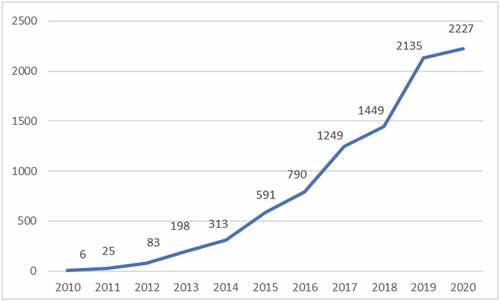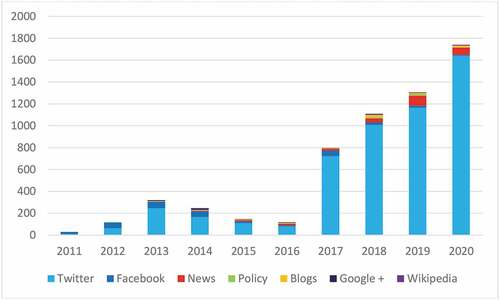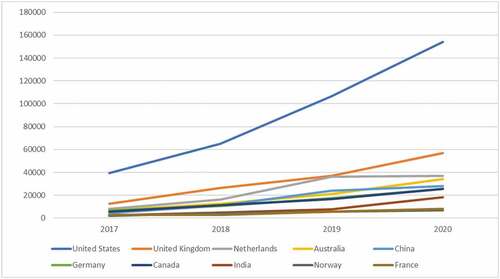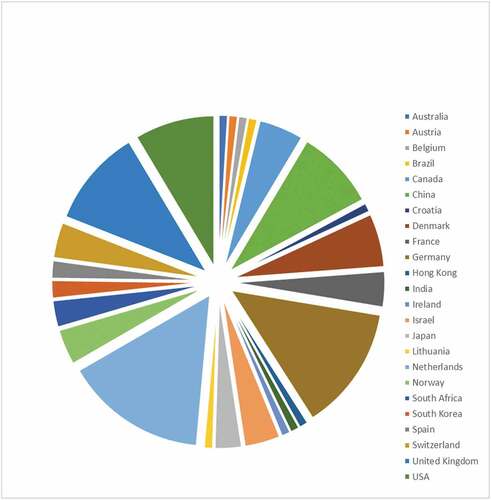ABSTRACT
The European Journal of Psychotraumatology, owned by the European Society for Traumatic Stress Studies (ESTSS), launched as one of the first full Open Access ‘specialist’ journals in its field. Has this Open Access model worked in how the Journal has performed? With the European Journal of Psychotraumatology celebrating its ten-year anniversary we look back at the past decade of sharing our research with the world and with how the journal sits with the broader movement beyond Open Access to Open Research and we present new policies we have adopted to move the field of psychotraumatology to the next level of Open Research. While we as researchers now make our publications more often freely available to all, how often do we share our protocols, our statistical analysis plans, or our data? We all gain from more transparency and reproducibility, and big steps are being made in this direction. The journal’s decennial performance as well as the exciting new Open Research developments are presented in this editorial. The journal is no longer in its infancy and eager to step into the next decade of Open Research.
HIGHLIGHTS
• In ten years European Journal of Psychotraumatology has grown towards a mature Open Access journal. • Newly adopted Open Research policies will facilitate research in psychotraumatology.
La Revista Europea de Psicotraumatología, propiedad de la Sociedad Europea de Estudios de Estrés Traumático (ESTSS), se lanzó como una de las primeras revistas “especializadas” de acceso abierto en su campo. ¿Ha funcionado este modelo de acceso abierto en el desempeño de la Revista? Celebrando con la Revista Europea de Psicotraumatología su décimo aniversario, recordamos la última década compartiendo nuestra investigación con el mundo y cómo la revista se relaciona con un movimiento más amplio, yendo más allá del Acceso Abierto hacia la Investigación Abierta, y presentamos las nueva políticas que hemos adoptado para mover el campo de la psicotraumatología al siguiente nivel de Investigación Abierta. Si bien, nosotros como investigadores, ahora hacemos que nuestras publicaciones estén más disponibles en forma gratuita para todos, ¿con qué frecuencia compartimos nuestros protocolos, nuestros planes de análisis estadísticos o nuestras bases de datos? Todos nos beneficiamos con una mayor transparencia y reproducibilidad, y grandes avances se han hecho en esta dirección. En esta editorial se presenta el desempeño decenal de la Revista, así como tambien los nuevos y emocionantes desarrollos de la Investigación Abierta. La revista ya no está en su infancia y está ansiosa por entrar a la próxima década de la Investigación Abierta.
Lo más destacado: En diez años la Revista Europea de Psicotraumatología, se ha convertido en una revista de acceso abierto madura. La reciente adopción de las políticas de Investigación Abierta facilitará la investigación en psicotraumatología.
欧洲创伤应激研究协会(ESTSS)旗下的《欧洲精神创伤学期刊》, 是该领域最早发行的完全开放获取“专业”期刊之一。开放获取模式是否在期刊的表现中起到推动作用?在《 欧洲精神创伤期刊》 庆祝其创刊十周年之际,我们回顾了与世界分享研究成果的十年,以及期刊在开放获取 到 开放研究的广泛运动中所处的位置,并总结了我们采用的新政策如何将精神创伤学领域推向开放研究的进一层面。 尽管作为研究者的我们现在可以更经常地向公众免费开放我们的发表文章,但是我们的研究方案、统计分析计划或数据有多经常被共享呢?我们都能受益于更高的透明度和可重复性,并已经朝着这个方向迈出了一大步。本文介绍了期刊十年来的表现以及令人振奋的开放研究的新进展 。我们的期刊已经告别了其蹒跚起步的阶段,迫不及待要跨入开放研究的未来十年。
重点:十年来,《 欧洲精神创伤学期刊》 已发展成为成熟的开放获取期刊。新近采用的开放研究 政策将促进精神创伤学的研究。
1. Introduction
We share a lot about ourselves today including opinions, photos, and cars, alongside our likes on social media, while in our living room, cats and children appear in our tele-conferences. When it comes to science and our research we are more constrained. While we have become more open to making our publications freely available to all, how often do we share our protocols, our statistical analysis plans, or our data? We all gain from more transparency and reproducibility, and big steps are being made towards Open Research.
The European Journal of Psychotraumatology, owned by the European Society for Traumatic Stress Studies (ESTSS) was launched 10 years ago as a gold Open Access journal. In this editorial, we evaluate 10 years of Open Access publishing of the journal and present the new policies we have adopted to move the field of psychotraumatology to the next level of Open Research.
2. Developments in open research
2.1. Open access
The European Journal of Psychotraumatology started as one of the first ‘specialist’ full Open Access journals in its field. This was quite an adventure 10 years ago when the Journal was launched (see also Olff, Citation2010, Citation2012, Citation2013, Citation2014, Citation2015, Citation2016, Citation2017, Citation2018, Citation2019; Olff & Bindslev, Citation2011) and Open Access was still novel for many. Although no other gold Open Access journal in the area of traumatic stress exists, more and more journals provide Open Access options; these are so-called ‘hybrid’ journals – subscription journals that offer the possibility to make an article freely available. A growing number of research funders (see here) are supporting or even requiring gold Open Access to publications resulting from their funding. In Europe, cOAlition S, a group of national research funding organizations and some independent foundations, have updated their Plan S to speed up the transition to Open Access. With important funders behind it (including the Bill and Melinda Gates Foundation from January 2021) and support from the European Commission and the European Research Council (ERC), the main principle underpinning Plan S is the following: ‘Plan S requires that, from 2021, scientific publications that result from research funded by public grants must be published in compliant Open Access journals or platforms’. (from https://www.coalition-s.org).
Our journal, gold Open Access from the start, was clearly on the right track. It is time for a next step looking at the entire research life cycle.
2.2. Transparency and the research life cycle
Publications that are freely accessible is an important step in Open Research, but Open Access alone is not enough. It is important to share more than the end result of research. Calls for transparency and reproducibility are moving us to opening up and sharing outputs along the entire research lifecycle, including study preparation, data acquisition, data processing and statistical analysis, to archiving and sharing open data, and in some cases open peer review and sharing of the preprint.
More transparency reduces Questionable Research Practices (QRPs, Wessel & Niemeyer, Citation2019), and moves us in the direction of Responsible Research Practices. QRPs, including for instance low statistical power, selective reporting of results, and publication bias have already led to the introduction of Registered Reports (Olff, Citation2019; Spiller & Olff, Citation2018, see also Centre for Open Science) whereby the background, hypothesis, methods and planned analyses are submitted for publication prior to beginning research, before results are known. The results of the research are then published regardless of outcome, if the researcher has followed the protocol laid out in the Registered Report. While this was implemented in the Journal in 2018, there was yet little encouragement to also share data once collected.
2.3. Sharing data
Imagine how we could speed up research if everyone shared what data they ethically could, both that which was recently collected and previously collected data sets that currently sit in a file cabinet. We could be much more efficient in collaborating on building and leveraging data sets. This is true not only for big datasets but there is a lot of potential in the many smaller psychotrauma research data sets (Ferguson, Nielson, Cragin, Bandrowski, & Martone, Citation2014; Kassam-Adams & Olff, Citation2020). Open data allow researchers from around the world to collaborate on important projects. During the current COVID-19 crisis, the importance of sharing research data has become even more evident with researchers working from home and looking for ways to connect, while seeking to solve a world pandemic as quickly as possible. Also, several funders and journals, including ours, have now adopted policies to encourage or require investigators to deposit data and make it accessible to others.
2.4. Where do we find traumatic stress data sets?
The journal very much supports the FAIR Guiding Principles stating that data should be Findable, Accessible, Interoperable, and Re-usable (FAIR). We encourage authors to make traumatic stress research data more FAIR and it all starts with finding the data.
Our vision for FAIR traumatic stress data as described by Kassam-Adams and Olff (Citation2020) is summarized in .
Figure 1. Vision for the future of FAIR traumatic stress data

The Global Collaboration on Traumatic Stress (GC-TS) has started an important initiative to collect information on where we can find traumatic stress data sets (see https://www.global-psychotrauma.net/fair). Researchers can inform each other on what data they have collected and how and under what conditions these can be re-used (see here). A win-win for all.
For publishing the data, one can make use of existing and reputable repositories. Qualified data repositories automatically create a Digital Object Identifier (DOI) or other permanent identifier that refers to the registration in the repository. The DOI can be included in the publication linking the publication and the dataset. Similarly, the meta data associated with the data set can be updated to include the DOI of the published article.
2.5. Why we do not share
According to the The State of Open Data Report 2019 (Fane et al., Citation2019), data sharing and attitudes associated with data sharing are moving in a positive direction. Yet, as Digital Science as well as the European Commission’s Facts and Figures for Open Research Data both show, authors’ attitudes reveal that they see the value in having access to others’ data, yet are less likely to share their own. As described by Kassam-Adams and Olff (Citation2020) there are several perceived barriers. Are we afraid of ‘being scooped’, of others using our data in ways we would have liked to use them? Are we hesitant that null-results may not be of interest for publication? Do we suffer from the competitive culture in academia where incentives are on publishing novel and positive results in high impact journals (Wessel & Niemeyer, Citation2019)? Do researchers not yet have the knowledge or skills required for making data FAIR?
There are situations whereby it is not possible to be fully Open but there are several ‘in between’ options to share what is possible. Data can be FAIR, even when they cannot (or should not) be fully open (, European Commission, Citation2018). Furthermore, most journal policies do not require an author to share full set of raw data, but rather the sub-set of data that underpins the analysis presented in a publication. In Kassam-Adams and Olff (Citation2020) we addressed potential barriers to data sharing and strategies to address them (). The strategies include capacity-building actions on the part of stakeholders to support researchers as well as actions that can shift research culture towards recognizing and rewarding open practices.
Figure 3. Barriers to data sharing and strategies to address them
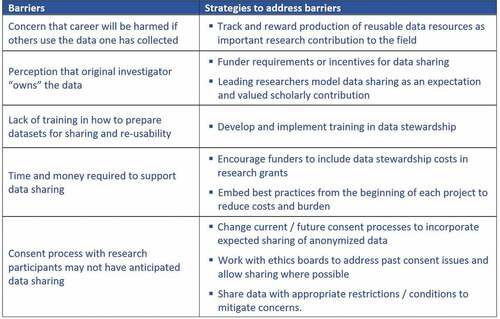
Data availability statement (DAS)In the European Journal of Psychotraumatology we now also ask authors if their study data can be made accessible for reuse by other researchers. We recommend doing this unless there are ethical, intellectual or commercial property issues that forbid this. Obviously, conditions for reuse and/or an embargo period can be defined.
Authors submitting their paper to EJPT will be prompted to provide a brief data availability statement (DAS). This tells the reader where the data associated with a paper is available, and under what conditions the data can be accessed. They also include links (where applicable) to the data set. DAS templates can be found here.
2.7. Open science badges
Finally, to further stimulate and visualize Open Science practices we have recently introduced the Open Science Badges (). These badges were designed by the Centre for Open Science (COS) to acknowledge open science practices. We are very happy to support this with our journal. The badges are offered as incentives to share data, materials, or to preregister. Authors may apply for one or more of the badges during submission and when the paper is accepted, the badge(s) will be displayed within the html and pdf versions of the article on Taylor & Francis Online.
3. Ten years of the European Journal of Psychotraumatology
3.1. What content do we share in EJPT?
In the 10 years that the European Journal of Psychotraumatology has existed as the first and still only gold Open Access journal in our field, we have shared the latest science, clinical practice papers or conference abstracts, without any barriers to access. It was an explicit aim to make the knowledge we generate on important topics such as psychotrauma and its consequences, its underlying neurobiology, how to prevent and treat it, available to all: researchers and clinicians, those in private practices without access to libraries, policymakers, patients and family members.
A word cloud based on article titles published over the past 10 years clearly shows what the journal is about (). This shows, not surprisingly, that the journal is about trauma and its wide range of consequences. The majority of articles cover posttraumatic stress disorder (PTSD), but we do see and encourage research on other outcomes including Complex PTSD, depression, anxiety, physical symptoms and neurobiological correlates. The cloud furthermore shows the range in types of research, from screening to treatment studies, from psychological to pharmacological, from e-health to complementary interventions, and the different populations studied, from refugees to military, from children to the elderly, work related or private events. The journal is open to any contribution on psychotrauma, from basic neuroscience to clinical practice, that in the end will benefit those who have experienced psychotrauma. The core topics we like to see addressed in the journal can also be found in last year’s editorial, introducing the 10 years anniversary year (see Olff et al., Citation2019). One also finds in top priorities for the future directions of the field of psychotraumatology and the journal.
3.2. Downloads, citations and altmetrics
The journal was launched on 6 December 2010. As shown below () over the past 10 years we see that we are sharing more research in the sense that the number of publications is overall gradually increasing, but we also see that researchers find them and cite them, and articles are being shared more and more on social media ().
The 2019 Impact Factor as announced by Clarivate Analytics Web of Science, Journal Citation Reports Social Science Edition is 3.478.
Which papers in the past 10 years have been attracting most readers (), have been most cited (), or received most social media attention ()?
Table 1. Most downloaded since January 2016 (all time data not available at the article level)
Table 2. Most cited papers of all time
Table 3. Highest altmetric scores of all time
Southwick et al. (Citation2014) article on definitions of resilience is the number 1 downloaded and cited paper, clearly a pivotal subject. Denckla et al. (Citation2020) have just published an update on this important topic reflecting the current discussions.
Ronald Kessler’s (Kessler et al., Citation2017) more recent paper on Trauma and PTSD in the WHO World Mental Health Surveys may be on its way to take over the number one position. Also, our associate editor Marylene Cloitre, Garvert, Brewin, Bryant, and Maercker (Citation2013, Citation2014) papers attract a good readership. Interestingly, the highest Altmetric score come from a very recent paper by De Jongh et al. (Citation2020) on brief intensive treatment.
3.3. Special issues
Over the past 10 years, we have published a series of special issues or thematic clusters, themed around a topic of special importance at the time (see below). Current special issues obviously cannot overlook the COVID-19 crisis. With an overwhelming number of submissions, we have decided to open it up for a part two. Below the most recently published:
Denckla, Gelaye, Orlinsky, and Koenen (Citation2020): REACH for mental health in the COVID19 pandemic: an urgent call for public health action;
Ertan et al. (Citation2020) COVID-19: urgency for distancing from domestic violence; or
Gersons, Smid, Smit, Kazlauskas, and McFarlane (Citation2020) on Can a ‘second disaster’ during and after the COVID-19 pandemic be mitigated?
3.3.1. Currently open special issues
The Coronavirus Pandemic and Traumatic Stress Part 2–1 April 2021 (guest editor Meaghan O’Donnell & associate editor Talya Greene).
Environmental Hazards and Traumatic Stress – 1 April 2021 (guest editor Meaghan O’Donnell).
Trauma, Memory and the Law – 1 December 2020 (guest editors Henry Otgaar & Marco Jelicic).
Stress, Trauma, and Related Conditions in Military, First Responders, Healthcare professionals and their Families – 1 June 2021 (associate editor Cherie Armour)
New: Biological mechanisms underlying adverse mental health outcome after trauma – 1 June 2021 (guest editor Mirjam van Zuiden).
Call-for-papers for the special issues can be found here: https://think.taylorandfrancis.com/ejpt/
3.3.2. Issues in progress with call closed
The Coronavirus Pandemic and Traumatic Stress Part 1 (guest editor Meaghan O’Donnell & associate editor Talya Greene)
Integrating and Evaluating Sex and Gender in Psychotrauma Research (Guest Editor: Willemien Langeland)
Complementary and integrative interventions for PTSD (guest editors Barbara Niles and Ariel Lang)
Sleep, Circadian Systems and Traumatic Stress (guest Editor: Agorastos T. Agorastos)
3.3.3. Past special issues
e-Health applications in the field of traumatic stress (Bakker, Riper, & Olff, Citation2020)
Traumatic loss: Mental health consequences and implications for treatment and prevention (Boelen, Olff, & Smid, Citation2019)
Children and natural disasters (Dyregrov, Yule, & Olff, Citation2018)
Interdisciplinary approaches to understand traumatic stress as a public health problem (Frewen, Schmahl, & Olff, Citation2018)
Child maltreatment across the lifespan (Hansen & Olff, Citation2017)
PTSD symptomics: network analyses in the field of psychotraumatology (Armour, Fried & Olff, Citation2017)
Traumatized refugees: identifying needs and facing challenges for mental healthcare (Knaevelsrud, Stammel, & Olff, Citation2017)
Systematic search of Bayesian statistics in the field of psychotraumatology (van de Schoot, Schalken, and Olff, Citation2017).
Trauma occurs in social contexts (Sijbrandij & Olff, Citation2016)
Erasing memory traces of trauma with eye movement desensitization and reprocessing therapy (Nijdam & Olff, Citation2016)
Back to Basics: Integrating Clinical and Scientific Knowledge to Advance the Field of Trauma – Highlights of the ISTSS-2015 (Elzinga, Schmahl, & Olff, Citation2016)
Global mental health and trauma: the current evidence and the long road ahead (Purgato & Olff, Citation2015)
Trauma and PTSD: setting the research agenda (Olff et al., Citation2015)
Intimate Partner Violence and Mental Health (Sprague & Olff, Citation2014; Olff & Wall, Citation2014)
Resilience after trauma: from surviving to thriving (Nugent, Sumner, & Amstadter, Citation2014)
Posttraumatic stress: state-of-the-art research and clinical implications for China (Olff & Tan, Citation2014).
PTSD in the military: special considerations for understanding prevalence, pathophysiology and treatment following deployment (Yehuda, Vermetten, McFarlane, & Lehrner, Citation2014)
20 Years of European Society for Traumatic Stress (Lueger-Schuster, Citation2013)
Psychotrauma research in the Netherlands (Olff & Vermetten, Citation2013)
Offending behaviour: the role of trauma and PTSD (Vittoria Ardino, Citation2012)
3.4. An international journal?
What countries do download and publish in the journal? Most downloads come from the United States (), while authors publishing in the journal seem to come from all over the world with a much more even spread over the continents (). There is a strong international growth visible over the years in some specific countries. A few examples:
In China, we note that downloads have grown by 525% (from 4 k to 25 k) since 2017. Authors from China account for 7% of submissions and 8% of total output so far this year. Top cited paper with a first author based in China is ‘The underlying dimensions of DSM-5 PTSD symptoms and their relations with anxiety and depression in a sample of adolescents exposed to an explosion accident’ (Yang et al., Citation2017, 24 cites)
In India, downloads have grown by 700% (from 2 k to 16 k) since 2017. There are, however, few submissions and publications yet.
We are also pleased to reach more African countries. For instance, downloads from South Africa grew from 0.7 k in 2017 to 8 k in 2020, an increase of over 1000%. Top cited paper with a first author based in South Africa is ‘Psychological trauma and posttraumatic stress disorder: risk factors and associations with birth outcomes in the Drakenstein Child Health Study’ (Koen et al., Citation2016b, 15 cites).
In Israel, a country with a relatively strong tradition of psychotrauma research (like the Netherlands, see Olff & Vermetten, Citation2013) submissions have grown in past couple of years as well as downloads, 1.3 k in 2017 rising to 5 k in 2020 so far. Top cited papers with first authors based in Israel are ‘Social relationship satisfaction and PTSD: which is the chicken and which is the egg?’ (Freedman, Gilad, Ankri, Roziner, & Shalev, Citation2015a, 24 cites) and ‘Early intervention for preventing posttraumatic stress disorder: an Internet-based virtual reality treatment (Freedman et al., Citation2015a, also 24 cites).
3.5. Editorial team & review process
As founding editor of the journal, I have had the opportunity to work with many psychotrauma experts over the past 10 years, all whom have helped to create the current high impact journal. With the increase in submissions, we needed to expand the editorial team. The current editorial team consists of a group of highly committed associate editors (see ), some of whom have been with us from the start, of guest editors in charge of special issues, and our large editorial board who are our primary source for peer review.
It is wonderful to announce that as of November 2020 Soraya Seedat, distinguished professor of psychiatry, holding the South African Research Chair in Posttraumatic Stress Disorder from the Department of Science and Technology and National Research Foundation, has joined the team of associate editors.
I am very grateful to all editors who quite often spend their free weekends on the journal. Our articles undergo double blind peer review. Our editorial board, with members from around the world serve as ambassadors of the journal and are committed to carrying out a minimum number of reviews per year.
We aim for a first decision within a month. With the increasing number of publications, and fewer reviewers available – possibly also due to COVID-19, it was at times challenging to find reviewers, but with a committed team and many external reviewers, we managed to keep the timelines as short as possible. The acceptance rates have slowly decreased and is currently at 54%. We currently are at 35 days (median) until first decision. It is only because of the commitment and associate but also guest editors, and our team of reviewers that we can assure a high quality and relatively fast review process.
Box 1. Editorial team of European Journal of Psychotraumatology
4. The next 10 years
We are looking forward to the next decade, with exciting content and a lively discussion on topics that matter so much to those who have experienced trauma in their lives (see Olff et al., Citation2019 for the research agenda for the coming 10 years). We are grateful for the continued trust and support for European Society for Traumatic Stress Studies (ESTSS), and the management of the journal by dedicated staff at Taylor & Francis, the publisher. We hope to build further on a journal with policies that reinforce openness and transparency, and thereby enhance quality output as well as making life easier for individual researchers around the world, such as allowing null-results to be published. The content being shaped within the Open Research framework and sound research ethics will expand our knowledge about all facets of trauma and its consequences, how to prevent and treat it, and be available to all without any barriers to access around the world.
Disclosure statement
M. Olff is Editor-in-Chief of the European Journal of Psychotraumatology.
Data Availability Statement
All journal data presented can be found through the presented links or from the author.
References
- Ardino, V. (2012). Offending behaviour: The role of trauma and PTSD. European Journal of Psychotraumatology , 2012, 3. doi: 10.3402/ejpt.v3i0.18968.
- Armour, C. , Fried, E. I. , & Olff, M. (2017). PTSD symptomics: Network analyses in the field of psychotraumatology. European Journal of Psychotraumatology , 8(sup3), 1398003. doi:10.1016/j.jhydrol.2012.06.054
- Bakker, A. , Riper, H. , & Olff, M. (2020). e-Health applications in the field of traumatic stress. European Journal of Psychotraumatology , 11(1), 1. 10.1080/20008198.2020.1762317
- Boelen, P. A. , Olff, M. , & Smid, G. E. (2019). Traumatic loss: Mental health consequences and implications for treatment and prevention. European Journal of Psychotraumatology , 10(1), 1. https://doi.org/10.1080/20008198.2019.1591331
- Cloitre, M. , Garvert, D. W. , Brewin, C. R. , Bryant, R. A. , & Maercker, A. (2013). Evidence for proposed ICD-11 PTSD and complex PTSD: A latent profile analysis. European Journal of Psychotraumatology , 4(1), doi:10.3402/ejpt.v4i0.20706.
- Cloitre, M. , Garvert, D. W. , Weiss, B. , Carlson, E. B. , & Bryant, R. A. (2014). Distinguishing PTSD, complex PTSD, and borderline personality disorder: A latent class analysis. European Journal of Psychotraumatology , 5(1). doi:https://doi.org/10.3402/ejpt.v5.25097.
- De Jongh, A. , Groenland, G. N. , Sanches, S. , Bongaerts, H. , Voorendonk, E. M. , & Van Minnen, A. (2020). The impact of brief intensive trauma-focused treatment for PTSD on symptoms of borderline personality disorder. European Journal of Psychotraumatology , 11(1) https://doi.org/10.1080/20008198.2020.1721142.
- Denckla, C. A. , Cicchetti, D. , Kubzansky, L. D. , Seedat, S. , Teicher, M. H. , Williams, D. R. , & Koenen, K. C. (2020). Psychological resilience: An update on definitions, a critical appraisal, and research recommendations. European Journal of Psychotraumatology , 11(1). doi:10.1080/20008198.2020.1762995.
- Denckla, C. A. , Gelaye, B. , Orlinsky, L. , & Koenen, K. C. (2020). REACH for mental health in the COVID19 pandemic: An urgent call for public health action. European Journal of Psychotraumatology , 11(1), 1762995. doi:10.1080/20008198.2020.1762995
- Dyregrov, A. , Yule, W. , & Olff, M. (2018). Children and natural disasters. European Journal of Psychotraumatology , 9(Suppl sup2). doi:10.1080/20008198.2018.1500823.
- Elzinga, B. , Schmahl, C. , & Olff, M. (2016). Back to basics: Integrating clinical and scientific knowledge to advance the field of trauma-highlights of the ISTSS-2015. European Journal of Psychotraumatology , 7(1). doi:10.3402/ejpt.v7.33765.
- Ertan, D. , El-Hage, W. , Thierrée, S. , Javelot, H. , & Hingray, C. (2020). COVID-19: Urgency for distancing from domestic violence. European Journal of Psychotraumatology , 11(1). doi:10.1080/20008198.2020.1800245
- European Commission . (2018). Turning FAIR into reality (Final report and action plan from the European Commission expert group on FAIR data). Brussels: Author.
- Fane, B. , Ayris, P. , Hahnel, M. , Hrynaszkiewicz, I. , Baynes, G., & Farrell, E. (2019). The State of open data report 2019. Digital Science. doi:10.6084/m9.figshare.9980783.v2
- Ferguson, A. R. , Nielson, J. L. , Cragin, M. H. , Bandrowski, A. E. , & Martone, M. E. (2014). Big data from small data: Data-sharing in the ‘long tail’ of neuroscience. Nature Neuroscience , 17(11), 1442.
- Freedman, S. A. , Gilad, M. , Ankri, Y. , Roziner, I. , & Shalev, A. Y. (2015a). Social relationship satisfaction and PTSD: Which is the chicken and which is the egg? European Journal of Psychotraumatology , 6, 28864. doi:10.3402/ejpt.v6.28864
- Frewen, P. , Schmahl, C. , & Olff, M. (2018). Interdisciplinary approaches to understand traumatic stress as a public health problem. European Journal of Psychotraumatology , 9, 1.
- Gersons, B. P. R. , Smid, G. E. , Smit, A. S. , Kazlauskas, E. , & McFarlane, A. (2020). Can a ‘second disaster’ during and after the COVID-19 pandemic be mitigated? European Journal of Psychotraumatology , 11(1), 1815283. doi:10.1080/20008198.2020.1815283
- Hansen, M. , & Olff, M. (2017). Child maltreatment across the lifespan. European Journal of Psychotraumatology , 8(Suppl sup7), 1483165. doi:10.1080/20008198.2018.1483165
- Kassam-Adams, N. , & Olff, M. (2020). Embracing data preservation, sharing, and re-use in traumatic stress research. European Journal of Psychotraumatology , 11(1), 1739885. doi:10.1080/20008198.2020.1739885
- Kessler, R. C. , Aguilar-Gaxiola, S. , Alonso, J. , Benjet, C. , Bromet, E. J. , Cardoso, G. , … Survey, W. W. M. H. (2017). Trauma and PTSD in the WHO world mental health surveys. European Journal of Psychotraumatology , 8. doi:https://doi.org/10.1080/20008198.2017.1353383.
- Knaevelsrud, C. , Stammel, N. , & Olff, M. (2017). Traumatized refugees: Identifying needs and facing challenges for mental health care. European Journal of Psychotraumatology , 8(sup2), 1388103. doi:10.1080/20008198.2017.1388103
- Koen, N. , Brittain, K. , Donald, K. A. , Barnett, W. , Koopowitz, S. , Mare, K. , … Stein, D. J. (2016b). Psychological trauma and posttraumatic stress disorder: Risk factors and associations with birth outcomes in the Drakenstein child health study. European Journal of Psychotraumatology , 7(1), 28720. doi:10.3402/ejpt.v7.28720
- Lueger-Schuster, B. (2013). 20 years of European society for traumatic stress. European Journal of Psychotraumatology , 2013, PMID: 23755327.
- Nijdam, M. J. , & Olff, M. (2016). Erasing memory traces of trauma with eye movement desensitization and reprocessing therapy. European Journal of Psychotraumatology , 7, 32545. doi:10.3402/ejpt.v7.32545
- Nugent, N. R. , Sumner, J. A. , & Amstadter, A. B. (2014). Resilience after trauma: From surviving to thriving. European Journal of Psychotraumatology , 5(1), 1. doi: 10.3402/ejpt.v5.25339
- Olff, M. (2010). European Journal of Psychotraumatology: The European society for traumatic stress studies launches new journal. European Journal of Psychotraumatology , 1. doi:10.3402/ejpt.v1i0.5768
- Olff, M. (2012). Advances in European psychotraumatology. European Journal of Psychotraumatology , 3(1), 20249. doi:10.3402/ejpt.v3i0.20249
- Olff, M. (2013). European Journal of Psychotraumatology (EJPT): Three years as an open access journal. European Journal of Psychotraumatology , 4(1), 23512. doi:10.3402/ejpt.v4i0.23512
- Olff, M. (2014). Are we happy with the impact factor? European Journal of Psychotraumatology , 5(1), 26084.
- Olff, M. (2015). Choosing the right instruments for psychotrauma related research. European Journal of Psychotraumatology , 6(1), 30585. doi:10.3402/ejpt.v6.30585
- Olff, M. (2016). Five years of European Journal of Psychotraumatology. European Journal of Psychotraumatology , 7(1), 31350. doi:10.3402/ejpt.v7.31350
- Olff, M. (2017). 2016: A year of records. European Journal of Psychotraumatology , 8(1), 1281533. doi:10.1080/20008198.2017.1281533
- Olff, M. (2018). Psychotraumatology on the move. European Journal of Psychotraumatology , 9(1), 1439650. doi:10.1080/20008198.2018.1439650
- Olff, M. (2019). Facts on psychotraumatology. European Journal of Psychotraumatology , 10(1), 1578524. doi:10.1080/20008198.2019.1578524
- Olff, M. , Amstadter, A. , Armour, C. , Birkeland, M. S. , Bui, E. , Cloitre, M. , … Thoresen, S. (2019). A decennial review of psychotraumatology: What did we learn and where are we going? European Journal of Psychotraumatology , 10(1), 1672948. doi:10.1080/20008198.2019.1672948
- Olff, M. , Armour, C. , Brewin, C. , Cloitre, M. , Ford, J. D. , Herlihy, J. , … Turner, S. (2015). Trauma and PTSD: Setting the research agenda. European Journal of Psychotraumatology , 6, 28092. doi:10.3402/ejpt.v6.28092
- Olff, M. , & Bindslev, A. (2011). European Journal of Psychotraumatology: One year later. European Journal of Psychotraumatology , 2(1), 15546.
- Olff, M. , & Tan, Z. (2014). Posttraumatic stress: State-of-the-art research and clinical implications for China. European Journal of Psychotraumatology , 5, 26479.
- Olff, M. , & Vermetten, E. (2013). Psychotrauma research in the Netherlands. European Journal of Psychotraumatology , 4(1), 20873.
- Olff, M. , & Wall, S. (2014). Intimate partner violence and mental health-remarks from two chief editors on a joint publishing venture. European Journal of Psychotraumatology , 5(1), 25679.
- Purgato, M. , & Olff, M. (2015). Global mental health and trauma: The current evidence and the long road ahead. European Journal of Psychotraumatology , 6(1), 30120. doi:10.3402/ejpt.v6.30120
- Sijbrandij, M. , & Olff, M. (2016). Trauma occurs in social contexts. European Journal of Psychotraumatology , 7(1), 1. doi: 10.3402/ejpt.v7.31389.
- Southwick, S. M. , Bonanno, G. A. , Masten, A. S. , Panter-Brick, C., & Yehuda, R. (2014). Resilience definitions, theory, and challenges: interdisciplinary perspectives. European Journal Psychotraumatol, 5. doi:10.3402/ejpt.v5.25338
- Spiller, T. R. , & Olff, M. (2018). Reducing uncertainty in research: Introducing registered reports. European Journal of Psychotraumatology , 9(1), 1554417. doi:10.1080/20008198.2018.1554417
- Sprague, S. , & Olff, M. (2014). Intimate partner violence and mental health. European Journal of Psychotraumatology , 5(1), 25580. doi:10.3402/ejpt.v5.25580
- van de Schoot, R. , Schalken, N. , & Olff, M. (2017). Systematic search of Bayesian statistics in the field of psychotraumatology. European Journal of Psychotraumatology , 8(sup1), 1375339. doi:10.1080/20008198.2017.1375339
- Wessel, I. , & Niemeyer, H. (2019). We need to change our attitude, and journals can help: Reflections in response to Spiller & Olff (2018). European Journal of Psychotraumatology , 10(1), 1614823. doi:10.1080/20008198.2019.1614823
- Yang, H. , Wang, L. , Cao, C. , Cao, X. , Fang, R. , Zhang, J. , & Elhai, J. D. (2017). The underlying dimensions of DSM-5 PTSD symptoms and their relations with anxiety and depression in a sample of adolescents exposed to an explosion accident. European Journal of Psychotraumatology , 8(1), 1272789. doi:10.1080/20008198.2016.1272789
- Yehuda, R. , Vermetten, E. , McFarlane, A. C. , & Lehrner, A. (2014). PTSD in the military: Special considerations for understanding prevalence, pathophysiology and treatment following deployment. European Journal of Psychotraumatology , 5(1), 1. doi: 10.3402/ejpt.v5.25322


